Skin pigmentation through sunlight

When the human skin is exposed to ultraviolet rays, a biosynthesis of melanin occurs. Melanin is a brown or black pigment which is produced in the melanosomes and protects the skin from damaging sun irradiation. Melanosomes are components of the melanocytes, which are special cells producing melanin (see Figure).
The enlarged part in the figure shows a melanocyte which produces pigments protecting the skin from damaging UV rays. Melanocytes are located in the basal cell layer of the epidermis. They form long, finger-like protuberances (dendrites) which grow into and through the neighboring keratinocytes. Keratinocytes are originally colorless skin cells.
Under the influence of ultraviolet light, cell components of the melanocytes fill up more and more with melanin and move further to the periphery of the cells and into the dendrites. Thus, the keratinocytes are filled up more and more with brown pigments, and a coloring of the skin occurs (see right hand side of Figure).
The formation of color pigments has the purpose to protect the skin and body from the negative influence of intensive sun irradiation. The melanin pigments filter the ultraviolet rays of the sunlight and thus prevent damages to the deeper skin layers.
If a protective cream is applied on the skin (see left hand side of Figure), the skin is additionally protected from damaging UV light. Special light protection measures are recommended, especially in the snow.
